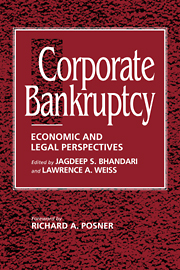Book contents
- Frontmatter
- Contents
- List of tables and figures
- Foreword by the HONORABLE RICHARD A. POSNER
- Preface
- Part I The role of credit
- Part II Bankruptcy as a reflection of the creditors' implicit bargain
- Part III Beyond the basic creditors' bargain
- Part IV Workouts or bargaining in the shadow of bankruptcy
- Part V Alternatives to bankruptcy and the creditors' bargain
- 21 Corporate control and the politics of finance
- 22 The uneasy case for corporate reorganizations
- 23 Bankruptcy and debt: A new model for corporate reorganization
- 24 A new approach to corporate reorganizations
- 25 Debtor's choice: A menu approach to corporate bankruptcy
- 26 Is corporate bankruptcy efficient?
- 27 The voting prohibition in bond workouts
- 28 Financial and political theories of American corporate bankruptcy
- Part VI Experience of other countries
- Index
26 - Is corporate bankruptcy efficient?
Published online by Cambridge University Press: 10 December 2009
- Frontmatter
- Contents
- List of tables and figures
- Foreword by the HONORABLE RICHARD A. POSNER
- Preface
- Part I The role of credit
- Part II Bankruptcy as a reflection of the creditors' implicit bargain
- Part III Beyond the basic creditors' bargain
- Part IV Workouts or bargaining in the shadow of bankruptcy
- Part V Alternatives to bankruptcy and the creditors' bargain
- 21 Corporate control and the politics of finance
- 22 The uneasy case for corporate reorganizations
- 23 Bankruptcy and debt: A new model for corporate reorganization
- 24 A new approach to corporate reorganizations
- 25 Debtor's choice: A menu approach to corporate bankruptcy
- 26 Is corporate bankruptcy efficient?
- 27 The voting prohibition in bond workouts
- 28 Financial and political theories of American corporate bankruptcy
- Part VI Experience of other countries
- Index
Summary
Corporate bankruptcy has two functions:
to deliver the penalty for failure by forcing a wrapping up when a business cannot pay its debts; and
to reduce the social costs of failure.
When a business fails, the legal process writes off claims that have become uncollectible, turns out managers and others responsible for the debacle, and pays the claims for which assets remain. Bankruptcy or a private substitute such as a workout succeeds when this happens quickly (before good money is thrown after bad) and with low transactions costs. Because the process of paying some claims and extinguishing others can lead to a race to carve up the carcass, which may still have a positive cash flow, bankruptcy combines a stay of self-help with a collective forum for the resolution of competing claims. Like the separation theorem of finance, the bankruptcy process divorces decisions about the optimal deployment of assets from decisions about the claims to those assets. If it works well, assets continue to be devoted to their most productive uses.
Bankruptcy certainly writes down claims, and Gilson (1990) finds that it leads to sanctions in the managerial labor market as well. Is the cost worth incurring? Every study of bankruptcy shows it to be expensive, as it is bound to be given creditors' incentives to stake out competing claims to whatever wealth remains. Weiss (1990) measures costs approximating 3 percent of the assets in the bankruptcies of substantial firms. Other estimates run between 3.4 percent and 21 percent for smaller firms.
- Type
- Chapter
- Information
- Corporate BankruptcyEconomic and Legal Perspectives, pp. 408 - 414Publisher: Cambridge University PressPrint publication year: 1996



